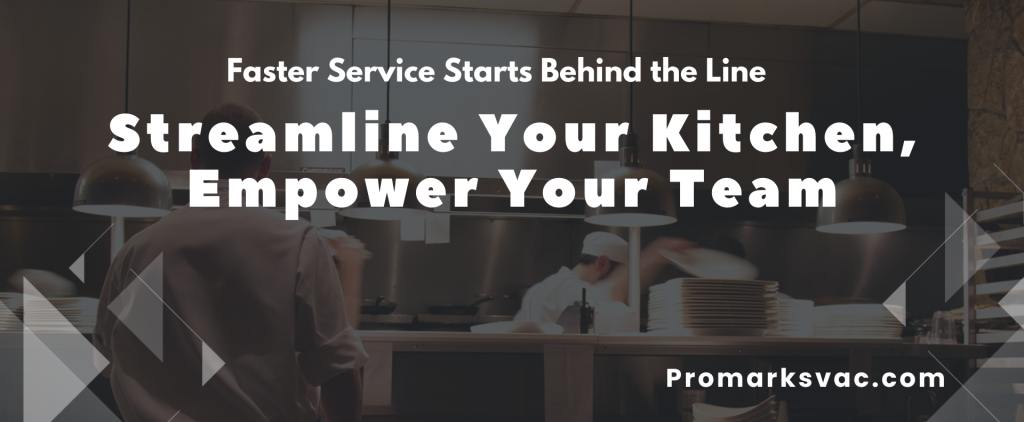
In the world of food service, speed isn’t just a competitive edge—it’s essential. Whether you’re running a fast-casual restaurant, a bustling bistro, or a high-volume catering operation, kitchen efficiency can make or break your reputation. Long ticket times frustrate both staff and customers, and over time, they can hurt your bottom line. The good news? Small adjustments in workflow, equipment, and staff coordination can lead to major gains in speed and consistency.
Here’s a practical guide to help streamline your kitchen for faster service—based on real-world kitchen dynamics, not just theory.
1. Start with a Kitchen Flow Audit
Before you start reworking anything, observe. Watch your kitchen during peak hours and track:
- Bottlenecks (Where do backups occur?)
- Repetition (Are staff taking extra steps unnecessarily?)
- Idle time (Where are delays creeping in?)
A simple observation can reveal inefficiencies you didn’t know existed. For instance, something as small as having the prep station too far from the cook line can cost you precious seconds every dish.
2. Declutter & Zone Strategically
Every tool, every ingredient, and every movement should have purpose and placement. Start by setting up specific kitchen zones:
- Prep zone: close to cold storage and slicing stations
- Cooking zone: surrounding the hot line and plating area
- Cleaning zone: isolated from food contact areas to avoid cross-contamination
Think of your kitchen like an assembly line. The fewer crossovers between stations, the better your output.
3. Prep Smart, Not Just Hard
Prepping everything in advance sounds ideal—until food quality suffers or spoilage increases. The solution? Batch prepping with high-performance equipment.
For instance, commercial vacuum packaging systems are a game-changer. They allow you to portion and seal ingredients ahead of time while preserving freshness. This means faster plating, less waste, and more control over portions.
One example we’ve seen work well in high-volume kitchens is Promarks’ vacuum sealers and tumblers. These tools help marinate proteins in minutes instead of hours and keep prepped items vacuum-packed for consistent taste and texture. They’re not about fancy tech—they’re practical, heavy-duty machines built to make daily kitchen operations smoother.
4. Train for Speed & Consistency
Speed shouldn’t compromise quality. Regular training ensures everyone on your team:
- Knows the menu and plating standards
- Understands kitchen layout and flow
- Communicates effectively during rush periods
Cross-training also helps—when a line cook can jump into prep or plating without missing a beat, the whole kitchen wins.
5. Use Prep Labels, Portion Control & Standard Recipes
Standardization might sound boring, but in a busy kitchen, it’s what keeps things moving. Make sure every station uses:
- Prep labels with dates and times
- Pre-weighed portions to eliminate guesswork
- Standard recipes and plating guides
Consistency speeds up decision-making, minimizes waste, and ensures every plate meets your brand’s standard.
6. Maintain Equipment Religiously
Downtime from equipment failure is a silent killer of service speed. Build a schedule for:
- Cleaning and descaling machines
- Lubricating moving parts
- Replacing seals, gaskets, and worn tools
Reliable equipment keeps your team confident and operations predictable. Again, equipment like the Promarks vacuum tumblers and sealers are known for their durability—something your kitchen staff will appreciate more than you might realize.
7. Keep Communication Clear & Concise
Install a kitchen display system (KDS) or use well-practiced hand signals and short phrases for real-time communication. During rush hours, even one misunderstood call can lead to a plate getting fired twice—or not at all.
Regular pre-service huddles also help align the team on what’s ahead, including any menu 86s or large party orders.
Final Thoughts
Streamlining your kitchen isn’t about working faster—it’s about working smarter. Every second saved in movement, prep, and plating translates to better service, happier customers, and a more profitable operation.
While layout and training are crucial, don’t overlook the power of professional-grade, reliable equipment that fits into your workflow seamlessly. Solutions like Promarks’ food processing and packaging tools aren’t there to replace your staff—they’re there to help them shine.
